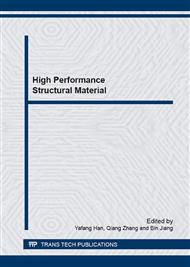[1]
T. Ishikawa, Advances in inorganic fibers, Adv. Polym. Sci. 178 (2005) 109-144.
Google Scholar
[2]
N. Igawa, T. Taguchi, T. Nozawa, L. L. Snead, T. Hinoki, J. C. McLaughlin, Y. Katoh, S. Jitsukawa, A. Kohyama, Fabrication of SiC fiber reinforced SiC composite by chemical vapor infiltration for excellent mechanical properties, J. Phys. Chem. Solids. 66 (2005).
DOI: 10.1016/j.jpcs.2004.06.030
Google Scholar
[3]
R.U. Hasse, and M. Kahlke, US Patent No. 5800157 (1998).
Google Scholar
[4]
S. Yajima, Y. Hasegawa, J. Hayashi, M. Imura, Synthesis of continuous silicon carbide fiber with high tensile strength and high Young's modulus, part 1, synthesis of polycarbosilane as precursor, J. Mater. Sci. 13 (1978) 2569-2576.
DOI: 10.1007/bf02402743
Google Scholar
[5]
S. Yajima, J. Hayashi, M. Omori, Continuous silicon carbide fibre of tensile strength, Chem. Lett. (1975) 931-934.
DOI: 10.1246/cl.1975.931
Google Scholar
[6]
S. Yajima, K. Okamura, T. Matsuzawa, Anomalous characteristics of the microcrystalline state of SiC fibres, Nature. 279 (1979) 706-707.
DOI: 10.1038/279706a0
Google Scholar
[7]
S. Yajima, T. Twai, Y. Yamamura, "Electrical resistivity of Si–Ti–C–O fibers after rapid heat treatment, J. Mater. Sci. 16 (1981), 1349-1355.
Google Scholar
[8]
D. Schawaller, B. Clauß, M. R. Buchmeiser, Ceramic Filament Fibers – A Review, Macromol. Mater. Eng. 297 (2012) 502-522.
DOI: 10.1002/mame.201100364
Google Scholar
[9]
M. D. Sacks, G. W. Scheiffele, M. Saleem, G. A. Staab, A. A. Morrone, T. J. Williams, Polymer-derived silicon carbide fibers with near-stoichiometric composition and low oxygen content, Mater. Res. Soc. Symp. Proc. 365 (1995) 3-10.
DOI: 10.1557/proc-365-3
Google Scholar
[10]
Y. Hasegawa, M. Iimura, S. Yajima, Synthesis of continuous silicon carbide fibre, J. Mater. Sci. 15 (1980) 720-728.
DOI: 10.1007/bf00551739
Google Scholar
[11]
E. Bouillon, D. Mocaer, J. F. Villeneuve, R. Pailler, R. Naslain, M. Monthioux, A. Oberlin, C. Guimon, G. Pfister, J. Mater. Sci. Composition-microstructure-property relationships in ceramic monofilaments resulting from the pyrolysis of a polycarbosilane precursor at 800 to 400 °C, 26 (1991).
DOI: 10.1007/bf00544661
Google Scholar
[12]
B. Clauss, 'Fibers for Ceramic Matrix Composites', in Ceramic Matrix Composites (Ed., W. Krenkel), Wiley-VCH, Weinheim2008, 1.
Google Scholar
[13]
S. Yajima, Special heat-resisting materials from organometallic polymers, Ceram. Bull. 62 (1983) 893-915.
Google Scholar
[14]
K. Kumagawa, Y. Yamaoka, M. Shibuya, T. Yamanura, Thermal stability and chemical corrosion resistance of newly developed continuous Si-Zr-C-O Tyranno fibers, Ceram. Eng. Sci. Proc. 18 (1997) 113-118.
DOI: 10.1002/9780470294437.ch12
Google Scholar
[15]
T. Ishikawa, Y. Kohtoku, K. Kumagawa, T. Yamamura, T. Nagasawa, High-Strength Alkali-Resistant Sintered SiC Fibre Stable to 2200℃, Nature. 391 (1998) 773-775.
DOI: 10.1038/35820
Google Scholar
[16]
T. Ishikawa, S. Kajii, T. Hisayuki, K. Matsunaga, T. Hogami, Y. Kohtoku, New type of sintered SiC fiber and its composite material, Key Eng. Mater. 15 (1995) 164-165.
DOI: 10.4028/www.scientific.net/kem.164-165.15
Google Scholar
[17]
D. C. Deleeuw, J. Lipowitz, J. A. Rabe, (Dow Corning Corporation), US 5268336 (1990).
Google Scholar
[18]
D. R. Bujalski, G. A. Zank, T. D. Barnard, (Dow CorningCorporation), US 5863848 (1991).
Google Scholar
[19]
P. Le Coustumer, M. Monthioux, A. Oberlin, Understanding Nicalon® fibre, J. Eur. Ceram. Soc. 11 (1993) 95-105.
DOI: 10.1016/0955-2219(93)90040-x
Google Scholar
[20]
G. Simon, A. R. Bunsell, Creep behaviour and structural characterization at high temperature of Nicalon SiC fibres, J. Mater. Sci. 19(1984) 3658-3670.
DOI: 10.1007/bf02396938
Google Scholar
[21]
T. Mah, N. L. Hecht, D. E. McCullum, J. R. Hoenigman, H. M. Kim, A. P. Katz, H. A. Lipsitt, Thermal stability of SiC fibres (Nicalon®), J. Mater. Sci. 19 (1984) 1191-1201.
DOI: 10.1007/bf01120029
Google Scholar
[22]
M. -H. Berger, N. Hochet, A. R. Bunsell, Microstructure and thermo-mechanical stability of a low-oxygen Nicalon fibre, J. Microsc. 177 (1995) 230-241.
DOI: 10.1111/j.1365-2818.1995.tb03554.x
Google Scholar
[23]
T. Taki, K. Okamura, M. Sato, T. Seguchi, S. Kawanishi, A study on the electron irradiation curing mechanism of polycarbosilane fibres by solid-state29Si high-resolution nuclear magnetic resonance spectroscopy, J. Mater. Sci. Lett. 7 (1988).
DOI: 10.1007/bf01730172
Google Scholar
[24]
J. J. Sha, T. Hinoki, A. Kohyama, Microstructure and mechanical properties of Hi-Nicalon™ Type S fibers annealed and crept in various oxygen partial pressures, Mater. Charact. 60 (2009) 796-802.
DOI: 10.1016/j.matchar.2009.01.017
Google Scholar
[25]
M. Takeda, A. Urano, J. Sakamoto, Y. Imai, Microstructure and oxidation behavior of silicon carbide fibers derived from polycarbosilane, J. Am. Ceram. Soc. 83 (2000) 1171-1176.
DOI: 10.1111/j.1151-2916.2000.tb01350.x
Google Scholar
[26]
C. Sauder, J. Lamon, Tensile creep behavior of SiC-based fibers with a low oxygen content, J. Am. Ceram. Soc. 90 (2007) 1146-1156.
DOI: 10.1111/j.1551-2916.2007.01535.x
Google Scholar
[27]
H. Ichikawa, K. Okamura, T. Seguchi, Oxygen-free ceramic fibers from organosilicon precursors and e-beam curing, Ceram. Trans. 58 (1995) 65-74.
Google Scholar
[28]
Y. Yamamura, T. Ishikawa, M. Shibuya, T. Hisayuki, K. Okamura, Development of a new continuous Si-Ti-C-O fibre using an organometallic polymer precursor, J. Mater. Sci. 23 (1988) 2589-2594.
DOI: 10.1007/bf01111919
Google Scholar
[29]
K. Kakimoto, T. Shimoo, K. Okamura, Oxidation-induced microstructural change of Si–Ti–C–O fibers, J. Am. Ceram. Soc. 81 (1998) 409-412.
DOI: 10.1111/j.1151-2916.1998.tb02348.x
Google Scholar


